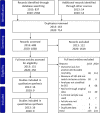The dose-response relationship between socioeconomic deprivation and alcohol-attributable mortality risk-a systematic review and meta-analysis
- PMID: 34736475
- PMCID: PMC8569998
- DOI: 10.1186/s12916-021-02132-z
The dose-response relationship between socioeconomic deprivation and alcohol-attributable mortality risk-a systematic review and meta-analysis
Abstract
Background: Individuals with low socioeconomic status (SES) experience a higher risk of mortality, in general, and alcohol-attributable mortality in particular. However, a knowledge gap exists concerning the dose-response relationships between the level of socioeconomic deprivation and the alcohol-attributable mortality risk.
Methods: We conducted a systematic literature search in August of 2020 to update a previous systematic review that included studies published up until February of 2013. Quantitative studies reporting on socioeconomic inequality in alcohol-attributable mortality among the general adult population were included. We used random-effects dose-response meta-analyses to investigate the relationship between the level of socioeconomic deprivation and the relative alcohol-attributable risk (RR), by sex and indicator of SES (education, income, and occupation).
Results: We identified 25 eligible studies, comprising about 241 million women and 230 million men, among whom there were about 75,200 and 308,400 alcohol-attributable deaths, respectively. A dose-response relationship between the level of socioeconomic deprivation and the RR was found for all indicators of SES. The sharpest and non-linear increase in the RR of dying from an alcohol-attributable cause of death with increasing levels of socioeconomic deprivation was observed for education, where, compared to the most educated individuals, individuals at percentiles with decreasing education had the following RR of dying: women: 25th: 2.09 [95% CI 1.70-2.59], 50th: 3.43 [2.67-4.49], 75th: 4.43 [3.62-5.50], 100th: 4.50 [3.26-6.40]; men: 25th: 2.34 [1.98-2.76], 50th: 4.22 [3.38-5.24], 75th: 5.87 [4.75-7.10], 100th: 6.28 [4.89-8.07].
Conclusions: The findings of this study show that individuals along the entire continuum of SES are exposed to increased alcohol-attributable mortality risk. Differences in the dose-response relationship can guide priorities in targeting public health initiatives.
Keywords: Alcohol use; Dose-response; Inequality; Mortality; Public health; Socioeconomic deprivation; Socioeconomic status.
© 2021. The Author(s).
Conflict of interest statement
The authors declare that they have no competing interests.
Figures



Similar articles
-
The socioeconomic profile of alcohol-attributable mortality in South Africa: a modelling study.BMC Med. 2018 Jun 25;16(1):97. doi: 10.1186/s12916-018-1080-0. BMC Med. 2018. PMID: 29936909 Free PMC article.
-
HIV/AIDS mortality attributable to alcohol use in South Africa: a comparative risk assessment by socioeconomic status.BMJ Open. 2018 Feb 21;8(2):e017955. doi: 10.1136/bmjopen-2017-017955. BMJ Open. 2018. PMID: 29467131 Free PMC article.
-
Socioeconomic status and mortality among dialysis patients: a systematic review and meta-analysis.Int Urol Nephrol. 2019 Mar;51(3):509-518. doi: 10.1007/s11255-019-02078-5. Epub 2019 Jan 28. Int Urol Nephrol. 2019. PMID: 30689180
-
Income inequality and alcohol attributable harm in Australia.BMC Public Health. 2009 Feb 25;9:70. doi: 10.1186/1471-2458-9-70. BMC Public Health. 2009. PMID: 19239715 Free PMC article.
-
The role of alcohol use and drinking patterns in socioeconomic inequalities in mortality: a systematic review.Lancet Public Health. 2020 Jun;5(6):e324-e332. doi: 10.1016/S2468-2667(20)30052-9. Lancet Public Health. 2020. PMID: 32504585
Cited by
-
Associations between social determinants of health and interpersonal violence-related injury in Cameroon: a cross-sectional study.BMJ Glob Health. 2022 Jan;7(1):e007220. doi: 10.1136/bmjgh-2021-007220. BMJ Glob Health. 2022. PMID: 35022181 Free PMC article.
-
Employment Status and Alcohol-Attributable Mortality Risk-A Systematic Review and Meta-Analysis.Int J Environ Res Public Health. 2022 Jun 15;19(12):7354. doi: 10.3390/ijerph19127354. Int J Environ Res Public Health. 2022. PMID: 35742600 Free PMC article.
-
Socio-economic vulnerability and deaths of despair in Brazilian counties.Prev Med Rep. 2024 Jan 20;38:102623. doi: 10.1016/j.pmedr.2024.102623. eCollection 2024 Feb. Prev Med Rep. 2024. PMID: 38375166 Free PMC article.
-
Global and regional burden of alcohol-associated liver disease and alcohol use disorder in the elderly.JHEP Rep. 2024 Jan 26;6(4):101020. doi: 10.1016/j.jhepr.2024.101020. eCollection 2024 Apr. JHEP Rep. 2024. PMID: 38515553 Free PMC article.
-
Educational attainment as a potential effect modifier of alcohol use and 100% alcohol-attributable mortality in the United States-A longitudinal analysis of mortality linked survey data from 1997 to 2018.Addiction. 2025 Jun;120(6):1143-1155. doi: 10.1111/add.16774. Epub 2025 Jan 27. Addiction. 2025. PMID: 39868514 Free PMC article.
References
-
- Strand BH, Grøholt EK, Steingrímsdóttir OA, Blakely T, Graff-Iversen S, Næss Ø. Educational inequalities in mortality over four decades in Norway: prospective study of middle aged men and women followed for cause specific mortality, 1960-2000. BMJ. 2010;340(c654):c654. doi: 10.1136/bmj.c654. - DOI - PMC - PubMed
-
- Mackenbach JP, Valverde JR, Bopp M, Bronnum-Hansen H, Deboosere P, Kalediene R, Kovacs K, Leinsalu M, Martikainen P, Menvielle G, et al. Determinants of inequalities in life expectancy: an international comparative study of eight risk factors. Lancet Public Health. 2019;4(10):e529–e537. doi: 10.1016/S2468-2667(19)30147-1. - DOI - PubMed
-
- Stringhini S, Carmeli C, Jokela M, Avendaño M, Muennig P, Guida F, Ricceri F, d'Errico A, Barros H, Bochud M, Chadeau-Hyam M, Clavel-Chapelon F, Costa G, Delpierre C, Fraga S, Goldberg M, Giles GG, Krogh V, Kelly-Irving M, Layte R, Lasserre AM, Marmot MG, Preisig M, Shipley MJ, Vollenweider P, Zins M, Kawachi I, Steptoe A, Mackenbach JP, Vineis P, Kivimäki M, Alenius H, Avendano M, Barros H, Bochud M, Carmeli C, Carra L, Castagné R, Chadeau-Hyam M, Clavel-Chapelon F, Costa G, Courtin E, Delpierre C, D'Errico A, Dugué PA, Elliott P, Fraga S, Gares V, Giles G, Goldberg M, Greco D, Hodge A, Irving MK, Karisola P, Kivimäki M, Krogh V, Lang T, Layte R, Lepage B, Mackenbach J, Marmot M, McCrory C, Milne R, Muennig P, Nusselder W, Panico S, Petrovic D, Polidoro S, Preisig M, Raitakari O, Ribeiro AI, Ribeiro AI, Ricceri F, Robinson O, Valverde JR, Sacerdote C, Satolli R, Severi G, Shipley MJ, Stringhini S, Tumino R, Vineis P, Vollenweider P, Zins M. Socioeconomic status and the 25 × 25 risk factors as determinants of premature mortality: A multicohort study and meta-analysis of 1.7 million men and women. Lancet. 2017;389(10075):1229–1237. doi: 10.1016/S0140-6736(16)32380-7. - DOI - PMC - PubMed
Publication types
MeSH terms
Grants and funding
LinkOut - more resources
Full Text Sources
Medical
Miscellaneous

